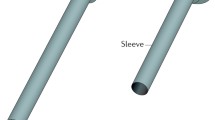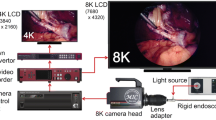Abstract
Background
In 1995, when we first used a high-definition television (HDTV) video system during a laparoscopic cholecystectomy in Tuebingen, we were surprised by the excellence of the spatial impression achieved by an image with improved resolution. Although any improvement in vision systems entails a trade-off among cost, quality, and complexity, high-definition imaging may well become an essential part of 3-D video systems. The aim of this experimental study was to assess the impact of high definition on surgical task efficiency in minimally invasive surgery and to determine whether it is preferable to use a 3-D system or a 2-D system with perfect resolution and color—for instance, HDTV or the three-chip charge-coupled device (3CCD).
Methods
We compared a 3-D video system with the vision through a stereoscopic rectoscope for transanal endoscopic microsurgery (TEM). Because its stereoscopic direct vision is not restricted to either shutter technology or video resolution, TEM optics represents the state of the art. For objective comparison, inanimate phantom models with suturing tasks were set up. The setups allowed the approach of parallel instruments as in TEM operations or via a laparoscopic approach, with oblique instruments coming laterally. Both types of procedure were carried out by highly experienced laparoscopic surgeons as well as those inexperienced in endoscopic surgery. These volunteers worked under 3-D video vision and/or TEM vision. Altogether, the model tasks were performed by 54 different persons.
Results
The evaluation did not show a significant (p >0.05) difference in performance time in all models, but there was a clear trend showing the benefit of a higher resolution.
Conclusion
We found a tendency for both endoscopically inexperienced and experienced surgeons to benefit from the use of a system with improved resolution (direct vision) rather than a 3-D shutter video system.
Similar content being viewed by others
References
Birkett DH (1994) Three-dimensional laparoscopy in gastrointestinal surgery. Int Surg 79: 357–360
Bueß G (1990) Transanale endoskopische Mikrochirurgie. In: Bueß G (ed.) Endoskopie—Von der Diagnostik bis zur neuen Chirurgie. Deutscher Ärzte-Verlag, Köln, pp 288–311
Bueß G, Hutterer F, Theiß J, Böbel M, Isselhard W, Pichlmaier H (1984) Das System für die transanale endoskopische Rektumoperation. Chirurg 55: 677–680
Buess GF, van Bergen P, Kunert W, Schurr MO (1996) Vergleichsstudie verschiedener 2-D und 3-D Sichtsysteme in der minimal invasiven Chirurgie. Chirurg 67: 1041–1046
Chan ACW, Chung SCS, Yim APC, Lau JYW, et al. (1997) Comparison of two-dimensional vs. three-dimensional camera systems in laparoscopic surgery. Surg Endosc 11: 438–440
Crosthwaite G, Chung T, Dunkley P, Shimi S, Cuschieri A (1995) Comparison of direct vision and electronic two- and three-dimensional display systems on surgical task efficiency. Br J Surg 82: 849–851
Dion YM, Gaillard F (1997) Visual integration of data and basic motor skills under laparoscopy: influence of 2-D and 3-D video-camera systems. Surg Endosc 11: 995–1000
Hanna GB, Shimi SM, Cuschieri A (1998) Randomised study of influence of two-dimensional versus three-dimensional imaging on performance of laparoscopic cholecystectomy. Lancet 351: 248–251
Herbert Schwind GmbH & Co. KG, Optische Geräte (1984) Betriebshandbuch Titmus II-S: 15
Jones DB, Brewer JD, Soper RN, Soper NJ (1996) The influence of three-dimensional video systems on laparoscopic task performance. Surg Laparosc Endosc 6: 191–197
Kunert W, Flemming E, Schurr MO, Buess GF (1997) Optik mit natürlicher Zusatzbeleuchtung. Langenbecks Arch Chir 2 (Suppl): 1232–1234
Lange T (1993) State of the art of videotechnique for endoscopic surgery. Endosc Surg 1: 29–35
Okudera H, Kobayashi S, Takemae T, Kyoshima K, Gibo H, Shibuya M, Sugita K (1992) Introduction of high definition television system to neurosurgical documentation. Neurol Res 14: 386–388
Peitgen K, Walz MV, Walz MK, Holtmann G, Eigler FW (1996) A prospective randomized experimental evaluation of three-dimensional imaging in laparoscopy. Gastrointest Endosc 44: 262–267
Shimosato Y, Yagi Y, Yamagishi K, Mukai K, Hirohashi S, Matsumoto T, Kodama T (1992) Experience and present status of telepathology in the National Cancer Center Hospital. Z Pathol 138: 413–417
van Bergen P, Kunert W, Buess GF (1998) Comparative study of different 2-D and 3-D vision systems for minimally invasive surgery. Surg Endosc 12: 948–954
van Bergen P, Kunert W, Buess GF (1998) 3-D vision systems: bichanneled-or single-channeled optics? (unpublished data)
van Bergen P, Kunert W, Schurr MO, Buess GF (1996) Vergleichs-studie Endoskopischer 2-D und 3-D Sichtsysteme. Langenbecks Arch Chir 2 (Suppl): 634–637
Author information
Authors and Affiliations
Rights and permissions
About this article
Cite this article
van Bergen, P., Kunert, W. & Buess, G.F. The effect of high-definition imaging on surgical task efficiency in minimally invasive surgery. Surg Endosc 14, 71–74 (2000). https://doi.org/10.1007/s004649900015
Received:
Accepted:
Issue Date:
DOI: https://doi.org/10.1007/s004649900015




